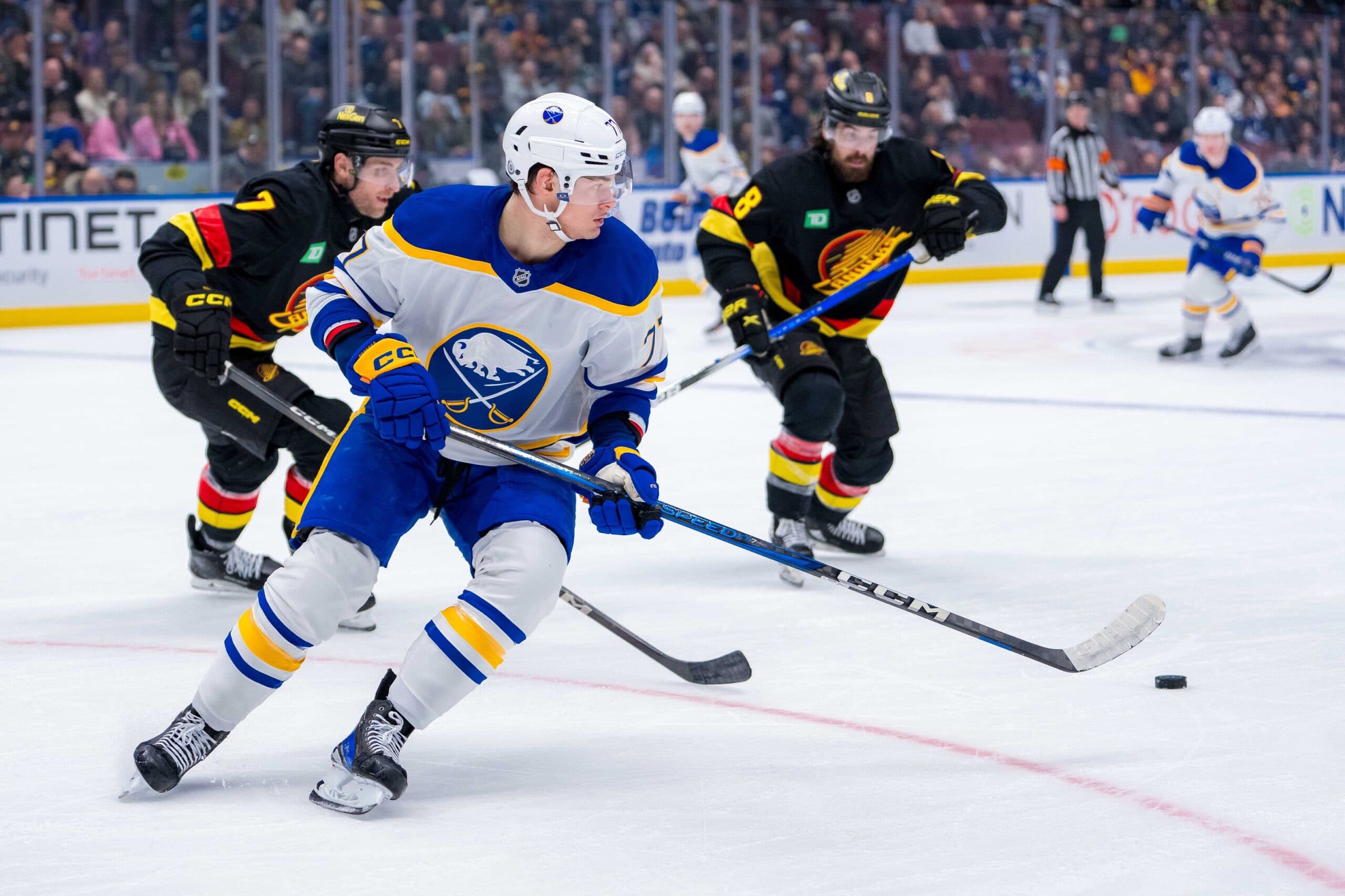Nation Sites
The Nation Network
CanucksArmy has no direct affiliation to the Vancouver Canucks, Canucks Sports & Entertainment, NHL, or NHLPA
Canucks offseason trade target: JJ Peterka

Photo credit: © Bob Frid-Imagn Images
Jun 25, 2025, 14:30 EDTUpdated: Jun 25, 2025, 14:18 EDT
JJ Peterka’s name is definitely one of the most interesting we’ll be covering in this series, and not just because of the intrigue around what the ‘JJ’ might stand for. (It’s John-Jason, apparently.)
If we were to pick out the single-most talented forward available on this summer’s trade market, Peterka would have to be high on the list, perhaps trailing only Jason Robertson of the Dallas Stars.
We’ve already written a lot about Vancouver Canucks targets, including the high skill level present in Minnesota’s Marco Rossi. It’s probably fair to say that Peterka belongs at least a tier higher, ability-wise. And if Peterka were a centre, instead of a winger, we’d probably have written about him as much as we have Rossi, if not more. That said, even as a wing, Peterka certainly makes a compelling enough potential target for the Canucks to make him worth writing about.
So, how does a player this talented even become available?
Well, not by the Buffalo Sabres’ own choice, it would seem.
Peterka, age 23, is a pending RFA whose current contract expires on July 1. Peterka is coming off his second consecutive breakout season, having followed up 27 goals and 50 points in 2023/24 with 28 goals and 68 points (in five fewer games) for 2024/25. Thus far, Peterka and the Sabres have yet to agree on the new contract he deserves.
And if you believe the whispers around the team, that might not be because of a dispute over salary or term, but location. Many seem to think that Peterka, more or less, wants out of Buffalo. He’d hardly be the first. And the fact that Sabres GM Kevyn Adams has plainly stated that he does not wish to trade Peterka, but that Peterka seems to be on the market all the same, would certainly indicate that there’s something to the notion of Peterka wanting out.
We’ve heard tell that the Canucks have already called on Peterka and it’s not a difficult rumour to believe. Every GM doing their job correctly should have already called on Peterka. You don’t let a player this good go through the market without at least kicking the tires.
So far, that’s all we’ve heard. The word on the street is that, trade request or no, the Sabres’ price tag for Peterka will be very, very high.
Too high for the Canucks? That one’s a little tougher to guess at, but we’ll do our best.
The Player
There’s not much to not like about what Peterka brings to the table.
Oddly enough, despite his talented profile, Peterka was not a first-round pick, instead going 34th overall in the 2020 Entry Draft. But he really turned heads at the 2021 World Junior Championships, where he popped off for four goals and 10 points in five games for Germany, and beyond that, he was considered a blue-chip prospect all the same.
Peterka spent the 2020/21 season in the DEL before coming over to North America for 2021/22. He had a hot debut for the Rochester Americans of the AHL, with 28 goals and 68 points in 70 games, followed by 12 points in a ten-game playoff run.
Peterka’s NHL rookie campaign came the following year, in 2022/23, and he managed a respectable 12 goals and 32 points in 77 games.
But Peterka was saving his big show for his sophomore season.
The 2023/24 season, as we’ve already mentioned, saw Peterka break out into 28 goals and 50 points in 82 games, really putting himself on the NHL map.
Then came the most recent 2024/25 season, and a further breakout into 27 goals and 68 points in 77 games. That made Peterka the second-leading scorer on Buffalo, trailing Tage Thompson by just four points.
All this, with Peterka having just turned 23 in January. We’re talking about a premium young talent here.
At 6’0” and a shade under 200 pounds for now, Peterka has decent enough size and checks off nearly every other box you can hope for. He’s got the skating ability to carry the puck up ice and the speed to create chances for himself with it. He’s said to be a very natural goal scorer with that knack for getting himself to the right areas. He’s not exactly physical, but has a reputation for digging out pucks in the corners and winning battles. His shot might be his greatest quality, which is why he’s already on the cusp of a 30-goal campaign.
If there’s a knock against Peterka, it’s against his defensive commitment. But that’s not exactly uncommon amongst young snipers, and we don’t imagine his upbringing in the Buffalo organization instilled him with much respect for systems and structure. If it’s an issue, it’s at least a solvable one.
He was listed as a centre/wing hybrid once upon a time, but Peterka has definitely settled into the wing position at the NHL level. But that only barely takes away from his value. All indications are that this is a player who will operate at a point-per-game or close to it for the foreseeable future.
So let’s skip ahead to the most important part of this conversation.
The Cost
If the Sabres have to give up Peterka, it’s pretty clear that they’ll be doing so begrudgingly. And with Peterka being an RFA, they have the ability to wait until the price is right. As a pending RFA, they’ll retain Peterka’s rights, even if he holds out without a contract well into the season. All the rumours agree that the cost is sky-high, with some going as far as to call the Sabres difficult to deal with when it comes to chasing Peterka.
None of that adds up to the Canucks, or any other team, getting anything close to a bargain here.
The question then is: how much is too much? At what point do the Canucks, and other teams, walk away from the pursuit of Peterka?
As we’ve mentioned when talking about other Buffalo trade targets, like Alex Tuch, the Sabres are known to be on the lookout for right-shooting defencemen. They’ve got Rasmus Dahlin, a LD who can play on the right, and Owen Power locked in as two former first overall picks. They’d love one or more high-quality RD to pair with them. That would seem to be their top offseason priority.
Thankfully, that’s one position at which the Canucks have an abundance to offer.
The top piece here is still Filip Hronek. We saw Hronek as a bit rich a price to pay for Tuch, with him being so close to unrestricted free agency, but for a player of Peterka’s calibre, age, and contract status, it’s certainly a more reasonable notion.
A Hronek-for-Peterka straight-up swap seems decent, value-wise, with perhaps Buffalo needing to add a bit on top due to Hronek’s lengthy, well-priced contract and the scarcity of his position.
Beyond that, the Sabres would obviously have interest in Tom Willander, someone they could pair with Dahlin or Power for the next decade, and to a lesser extent, Victor Mancini for the same reasons.
If it’s Willander going, the Canucks would still have to add a significant piece. Even a top prospect doesn’t add up to someone with Peterka’s early track record in the NHL. If it’s Mancini, they’d have to add multiple significant pieces, and we’re talking the territory of their first-round pick, and then some.
Speaking of the 15OA, it has definite value, but less to the Sabres than might be the case for other teams. They’re desperate to return to the playoffs after a decade-and-a-half away, and draft picks don’t really get them there, except as currency to use in other trades.
Suffice it to say that the Canucks have what it takes to land this player, but not without giving up at least one asset they’d rather not – and maybe then some, on top of that. It won’t be an easy call.
The cost of Peterka must also include his new contract. With the cap going up by leaps and bounds, he’s certainly picked a good time to have another breakout season. A good comparison might be Lucas Raymond of the Detroit Red Wings, who signed for eight years at an AAV of $8.075 million after a 2023/24 of 72 points in 82 games at age 22. But then, Raymond signed under the old flat cap era.
The folks at AFP Analytics have Peterka at a hair under $8 million AAV on a long-term deal of seven years, or an AAV of $4.6 million on a two-year bridge deal. Honestly, those projections feel a bit light.
If the Canucks, or any other team, paid a big price to acquire Peterka, they’d obviously want to get him under a long-term contract. It would probably cost them something in that $8 million range to do so, and that’s another thing that needs to be considered for an already pricey acquisition.
The Fit
This part, on the other hand, is easy. Peterka checks off a lot of boxes for the Canucks.
If we’re thinking of him as a Brock Boeser replacement, he’s essentially an upgrade across the board. Peterka does all the same things Boeser does well, like sniping goals and winning puck battles, but also holds his skating as a strong point, where that’s always been a weak point of Boeser’s.
The team signing Boeser this summer is going to pay him nearly as much as Peterka gets on his next contract, and they’re going to get Boeser from age 28 onward. The team that lands Peterka gets him from age 23 onward. It’s clear who will provide the better bang-for-buck there.
Simply put, unless Elias Pettersson can mount a bounceback in 2025/26, Peterka would join the Canucks’ roster as their clear-cut best forward, period. That said, one of the best ways we can imagine to ensure a Pettersson bounceback is to give him the most talented linemate possible, and in this market, it sure sounds like that’s Peterka.
With all due respect to the late great Brian Wilson, we don’t mind the idea of those Pet Sounds coming from the Canucks’ top line at all.
The Canucks need goals, and they value speed. If they’ve got a wishlist, Peterka is almost certainly at or near the top of it.
But that doesn’t mean he’s at the top of their shopping list. That status is price-contingent, and that will be the largest sticking point when it comes to the ongoing trade talks.
Sponsored by bet365
Breaking News
- Instant Reaction: Patrick Kane scores 499th and 500th NHL goals in Canucks’ 5-1 loss to Red Wings
- Laurence Gilman talks about how Canucks built a strong culture ahead of 2011 Stanley Cup run
- Canucks trade rumours: What can the Rangers offer up for Kiefer Sherwood?
- Canucks Game Day: Lankinen gets the nod vs. Red Wings
- Canucks’ Cootes talks World Juniors bronze, trade to Prince Albert, and more
